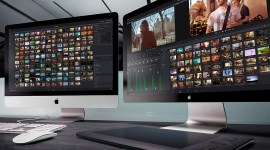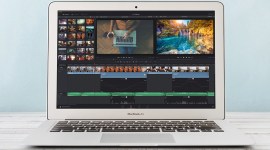
Key Differences Between DaVinci Resolve and Magic Bullet
Is one color grading tool that much better than the other? Let’s look at the differences between DaVinci Resolve and Magic Bullet.
I’ve spent the last few months bouncing back and forth between DaVinci Resolve 11 and Magic Bullet Suite 12 for color jobs, trying to determine how best to offer color grading services on a wide variety of projects. The journey started out as “What’s better, MBL or the Resolve?” and I’ve landed confusingly on “both.” You can grade in your edit, or you can edit in your grade.
These are the two options that we all face now when it comes to the question of DaVinci Resolve versus Magic Bullet. Both methods yield incredible results in a timely fashion, and the difference is philosophical as much as technical.

Most small to medium post companies doing ad work want me to color in the NLE, while filmmakers working on shorts and features want a Resolve session after picture lock.
It’s only going to get more polarized now that Premiere Pro CC 2015 includes in-timeline color grading. Plus, next month Resolve 12 will drop and include more “edit-y” features. The choice of which one to use will get more interesting. As we move toward this future, my only advice is to avoid the temptation to decide on a “best.” Feature films with famous actors have been colored in the Magic Bullet Suite and no-budget webisode videos have been graded in Resolve. That’s just the world we live in now.
Why You Should Love Resolve

If you have ever spent time in any of the Resolve wannabes or the more esoteric apps like SpeedGrade, then you will instantly fall in love with the grandmother of all digital grading platforms. Resolve used to cost as much as a small apartment, ran on proprietary hardware, and was reserved for the highest-end projects for high-paying clients.
There was a not-so-subtle schadenfreude among starving filmmakers when BlackMagic did the the unthinkable and gave the rabble the keys to the Ferrari. It wasn’t enough that we had a free DaVinci now, it was that the former high-end suites and artists knew we had a free DaVinci. Once again that tension thrived between the “barbarians at the gates” and the “elitists in the towers.” Resolve sets the standard for professional color grading apps, and the free version is more than most people will ever need. What’s not to love?
Why You Should Love Magic Bullet

Magic Bullet is not a Resolve knock-off. The tool set included in the suite is unique and intuitively designed for anyone that’s ever spent an hour working with video on a computer. There’s a balance between quick, easy-to-use presets and infinitely tweakable settings that allow for customization and complex grading effects. MBL can be as simple as a two-second drag and drop effect, or one could spend an hour noodling a shot until it’s “perfect.”
There is no easier way to start creating powerful, compelling looks if you know next to nothing about color grading. The development team at RedGiant is made up of filmmakers, DV Rebels, and techies that understand the workflows and hardware most low-budget filmmakers are using. They have created a constellation of applications that sit right on top of After Effects, Premiere, and FCPX. And there is an amazing community of dedicated users that share looks, tips and techniques, not just for color correction but for high-end image creation on a no-dollar budget.
When you get on board with Magic Bullet, you are joining a community of creators connected by a company dedicated to being a creative partner. It’s amazing. I have been involved with Magic Bullet, as a beta tester, advisor, and plug-ins packs developer since its creation nearly 15 years ago. There are very few software developers that are so integrated into a community of users than the folks at RedGiant.
The Big Differences
Both packages can be used for basic primary color correction (lift, gamma, gain), doing shot to shot matching, as well as secondary color correction using mattes and keys to target skin tones and specific regions of the image. Either package can be used to create stylized looks and both allow users to save and create presets. There’s really no limit.
Where the packages differ is in two areas, in my opinion: speed and ease-of-use. Here’s an experiment: get a stop watch and set up a tracking mask on a person’s face in Premiere/ Colorista and one in Resolve 11. This is probably the tool that I use the most once I’m done with primary color correction.
A secondary correction applied to a tracked mask on a face is used for “relighting” subjects, erasing wrinkles, and drawing attention to part of the frame. As a colorist, you’re going to use this endlessly, all day long.
Grab the stop watch and time how long each program takes to track that person’s face. Do it on the exact same hardware, make it apples to apples (so to speak).

Premiere Pro, even with a nice GPU on a fast machine, will clunk through a frame at a time, at a rate far below realtime. Frustratingly so. On the exact same machine, with the exact same clip, Resolve will blaze through the shot, tracking accurately and steady in realtime. This is, to me, the crucial difference. The ability to interact with masks that track in realtime enables a far more iterative and creative workflow. When using Premiere Pro’s built-in track, you, the user, are sidelined while the software plays catch up and figures out the track. Is it a deal breaker?
No, but it does require a lot of working around… and I am less likely to want to do all the nice relighting touches that can really make a shot pop off the screen. Keep in mind, this is not a problem inherent to Magic Bullet. This is the limitation of the Premiere Pro CC 2015 tracking tool. The end result is a limited kind of secondary workflow.

The flipside of this is ease-of-use. Quite simply, Magic Bullet is easy to use and Resolve is complicated. Magic Bullet’s tool sets live inside Premiere Pro’s effect window and you never leave your comfortable NLE. A decision to use Resolve, in all its powerful glory, is a decision to tackle a very, very steep learning curve.
If you’re inexperienced as a colorist, and a job falls in your lap that needs a color pass by the end of the day, you’re probably not going to hop into a Resolve session. However, Resolve is far easier to use and way less arcane that it used to be. As the product evolves, it is becoming way more “rabble friendly”.
Want to learn more about color grading? Check out a few of the following resources:
- 5 Reasons to Get a Color Grading Control Surface
- Key Workflow Tips For A Smooth Color Grading Process
- 3 Free Color Grading Tools
Which do your prefer, Magic Bullet or DaVinci Resolve? Share in the comments below.





